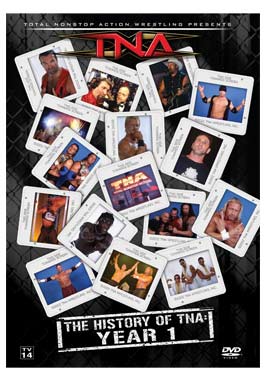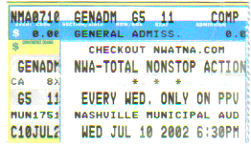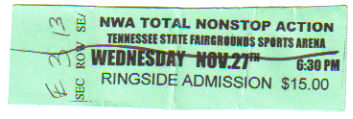In the business world, it is not often a company will admit mistakes to the public that nearly led to its demise let alone produce and market a DVD that details the experience; however, The History of TNA: Year 1 does just that.
The main menu, complete with the original TNA logo, consists of three categories: The Story, The Matches and Bonus materials.

The Story begins with the final audio check by Mike Tenay from TNA’s first pay-per-view held on June 19, 2002 in Huntsville, Alabama. Captions also explain to viewers the nature of the dialogue between Tenay and Don West in regards to last-minute format changes as the ring crew scrambled to repair a cable underneath the ring, which was broken in a dark match just prior to airtime. Essentially, this sets the tone for the documentary by foreshadowing the obstacles TNA would face.
Jeff Jarrett, Jeremy Borash and Bob Ryder start off by describing life after WCW and the origins of TNA. A few minutes into the DVD, Tenay grabbed my attention by stating, “Wow, weekly pay-per-view concept was one of those situations that had never been tried before. Was I optimistic about it? Hardly. But was it a means to an end? Absolutely. When you didn’t have that TV contract on a network, on a cable station, you had no opportunity to promote your pay-per-view shows. But without having the ability to have that contract, you had no other option. So, what TNA decided to do was to go on a week by week basis where you would go from one pay-per-view to the other and use that week’s show as your promotional tool to promote the next week’s show. So, optimistic about it? Not really. It was the only option at the time, and it proved really to be the smartest move ever.”
Tenay would be the first of many to explain his initial doubts in the success of the company, which is what makes this DVD so intriguing. Instead of glossing over both the external and internal doubts regarding TNA’s success ratio during their first year, the documentary tackles the subject head on.
“Outside of my wife, everyone to a ‘T’ doubted me,” recalled Jeff Jarrett in the DVD. “They didn’t tell me, but they didn’t have to tell me. I can look somebody in the eye — anybody can look somebody in the eye — and you know whether you got confidence or not.”
Highlights from the early shows provide nice segues between chapters such as country music star Toby Keith’s appearance at the first pay-per-view and Ron “The Truth” Killings winning the NWA World Heavyweight Championship.

Proof that Ryan was around those early TNA shows.
TNA’s initial financial woes are also addressed briefly although the HealthSouth Corporation (TNA’s financial backer at the time) is never mentioned by name. The same applies to the erroneous information being supplied to TNA by their former pay-per-view consultant, Jay Hassman, although Hassman is also never mentioned by name.
The only real drawback to the documentary is that it only contains interviews with a select group of people employed with the company. Although they are mentioned in passing, I would had like to have seen interviews with Jerry Jarrett, Bob Carter, Vince Russo, Ed Ferrara, Bert Prentice, among many others who played pivotal roles during the first year.
The four matches from the weekly pay-per-views within The Matches section include:
- June 26, 2002: X Title Elimination match featuring AJ Styles vs. Psicosis vs. Low-Ki vs. Jerry Lynn
- August 28, 2002: X-Division Triple Ladder match featuring Jerry Lynn vs. AJ Styles vs. Low-Ki
- January 8, 2003: NWA World Tag Team Championship match featuring AMW vs. Disciples of the New Church
- April 30, 2003: NWA World Heavyweight Championship match featuring Raven vs. Jeff Jarrett
Bonus materials include various cameo appearances during the first year, the original TV commercial that aired in the Nashville market, Chris Harris and James Storm’s tryout for TNA match during a USA Championship Wrestling event, and a Curt Hennig tribute piece.

The DVD took me down memory lane, as I was fortunate enough to attend some of the early shows at the Nashville Municipal Auditorium and the Asylum. If you pay close attention, you can even spot the “legendary” fan Chicken Hat Charlie in all his glory sporting his porno mustache while sitting ringside … you just had to be there.
Overall, The History of TNA: Year 1 is a must have for fans wanting to know about TNA’s past; however, I recommend those same fans also pick up a copy of the book The Story of the Development of the NWATNA by Jerry Jarrett for a more detailed account of the early days of the company.
RELATED LINKS
- December 6, 2007: Retro book review: Early days of TNA extra relevant now
- Jarrett family story archive – Jerry, Jeff, Christine
Ryan Nation vividly remembers his Wednesday trips from Cookeville, Tennessee to Music City USA to record interviews at the Asylum for his college radio show. He also wonders if TNA will ever hold another show at the Asylum for old time’s sake.

